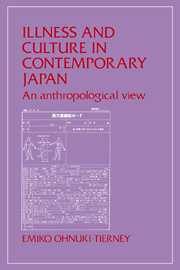Book contents
- Frontmatter
- Contents
- List of illustrations
- Acknowledgments
- 1 Introduction
- Part I Basic concepts and attitudes toward health and illness
- Part II Medical pluralism
- 5 Kanpō: Traditional Japanese medicine of Chinese origin
- 6 Medical roles of Japanese religions: A descriptive overview
- 7 Medical roles of Japanese religions: A historical-symbolic interpretation
- 8 Doctors and outpatients: Biomedicine (I)
- 9 Hospitalization: Biomedicine (II)
- 10 Medical pluralism
- Summary
- References
- Index
7 - Medical roles of Japanese religions: A historical-symbolic interpretation
Published online by Cambridge University Press: 12 January 2010
- Frontmatter
- Contents
- List of illustrations
- Acknowledgments
- 1 Introduction
- Part I Basic concepts and attitudes toward health and illness
- Part II Medical pluralism
- 5 Kanpō: Traditional Japanese medicine of Chinese origin
- 6 Medical roles of Japanese religions: A descriptive overview
- 7 Medical roles of Japanese religions: A historical-symbolic interpretation
- 8 Doctors and outpatients: Biomedicine (I)
- 9 Hospitalization: Biomedicine (II)
- 10 Medical pluralism
- Summary
- References
- Index
Summary
To reveal further the medical roles Japanese religions have played, the emphasis in this chapter switches from description to a more interpretive perspective within a historical framework. In presenting both types of information in these two chapters, I hope to arrive at a comprehensive picture of the medical roles played by Japanese religions.
Background
Shintoism, Buddhism, Confucianism, and shamanism and various other folk religions have been the religions of Japan. Shintoism, the only religion of indigenous origin, and Buddhism have traditionally been regarded as the most important. It has often been pointed out that these religions have permeated the daily lives of the Japanese; they have become part of their customs without requiring any psychological commitment on the part of the individual. Most Japanese subscribe to more than one religion, often without consciously realizing it. The annual statistics on Japanese religious affiliation consistently list the total membership in various religious organizations as one and a half times the total population of Japan. In other words, over half of the people in Japan belong to more than one religious organization. The most recent figures available are for the six years between 1967 and 1978 and are presented in Table 2 and Figure 2. All these religions are polytheistic, and together they provide the Japanese with a rich and colorful pantheon composed of millions of deities, buddhas, deified ancestors, spirits, and other supernatural beings.
There is a long history of scholarly debate on the nature of the religious beliefs and attitudes of the Japanese, especially regarding the meaning of simultaneous subscription to more than one religion.
- Type
- Chapter
- Information
- Illness and Culture in Contemporary JapanAn Anthropological View, pp. 145 - 166Publisher: Cambridge University PressPrint publication year: 1984

